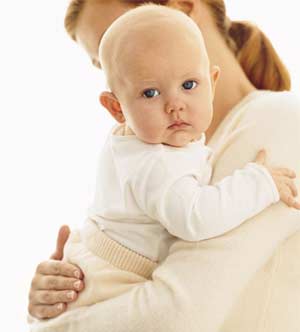When your child is sick, their fatigue and fussiness can often leave you feeling exhausted and confused. Your care might sometimes make your child even more uncomfortable… You may be wondering what to do?
Should you take your child to the doctor if they have a high fever?
 |
|
With a mother by their side, a child will feel much more comforted |
Even if your child has a high fever, it is still advisable to take them to the clinic, as only there will the doctor have the necessary tools to examine your child.
Do you need to cover your child with blankets?
If your child has a fever, do not add extra blankets as this will raise their body temperature further. Keep the room temperature between 20°C – 22°C, ensuring no drafts; under these conditions, your child only needs to wear a loose-fitting, breathable nightgown.
How should you care for your child to make them comfortable?
The room should be well-ventilated and sufficiently warm.
If you haven’t opened the windows for a while, consider moving your child to another room temporarily while you clean: sweeping the floor, changing bed linens, etc. Afterward, you can close the door if necessary to prevent drafts and bring your child back.
Every day, continue to wash your child’s face, neck, and hands and feet as usual.
You can give your child a bath, but ensure the water is at a temperature of 37°C and that the bathroom is enclosed and free from drafts.
During their illness, every child wants their parent, grandparent, or caregiver nearby. This presence reassures and comforts them during uncomfortable moments. If adults cannot be close, consider providing toys or colorful picture books for entertainment.
Avoid letting your child see the worried or sad expressions of adults regarding their condition.
What to do when your child sweats a lot?
If your child has a fever and is sweating, that is a good sign. It indicates that their body is trying to lower the temperature. You should dry the sweat and change their clothes.
Should you force your child to stay in bed?
If your child feels tired, they will naturally rest. However, if they do not want to lie down, do not force them. Allow them to sit up or walk around the room, but make sure they wear socks.
For children who are ill and need long-term treatment or are in recovery, let them play normally. Just avoid stimulating games and prevent them from playing with other children to avoid spreading infections.
What should the diet of a sick child look like?
For infants, if they are not experiencing diarrhea, you can feed them normally: do not force them to eat, but ensure they stay hydrated. If the child has diarrhea, stop breastfeeding and follow a special diet.
For older children, you can provide soup, vegetable broth, mashed bananas, toasted bread, or biscuits. If they show signs of recovery, gradually return to their normal diet.
Note: Do not force children to eat.
If your child has a fever, ensure they drink plenty of fluids during the day and night, as fever causes dehydration. In addition to plain water, you can offer orange juice, lemonade, soup, vegetable broth, and sweetened water, etc.
Generally, children prefer cool drinks over warm ones. Provide them with cool liquids—especially if they often vomit. If they refuse to eat, sweetened water, soup, honey, or rice water can also provide some calories.
What should the care schedule look like?
Establish a routine, for example, in the morning and at 5 PM, you will take the child’s temperature, wash their face, clean their nose, give medicine, or apply ointments. Having a set schedule for care can be less tiring for the child than scattered treatment throughout the day.
After caring for your child, make sure to record their temperature readings from the morning and afternoon, along with any symptoms (if any) such as vomiting, diarrhea, or coughing, to prepare for the doctor’s visit or a phone consultation.
If your child has a contagious illness, isolate them from other children, including pregnant adults.
Note: Do not leave medications within the child’s reach. Many people keep medications for their children near where they sleep for convenience, which can be very dangerous, especially for children who tend to put anything unfamiliar into their mouths.
Medications must also be taken at the correct dosage and at the right times.
Young children are often attracted to the colors of pills or the sweet taste of medications.
Dr. PHAM XUAN HAU – Family & Society Newspaper


















































